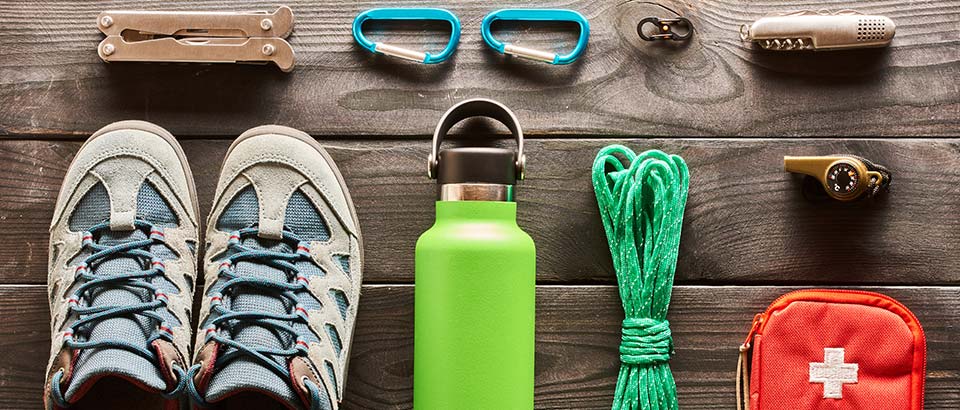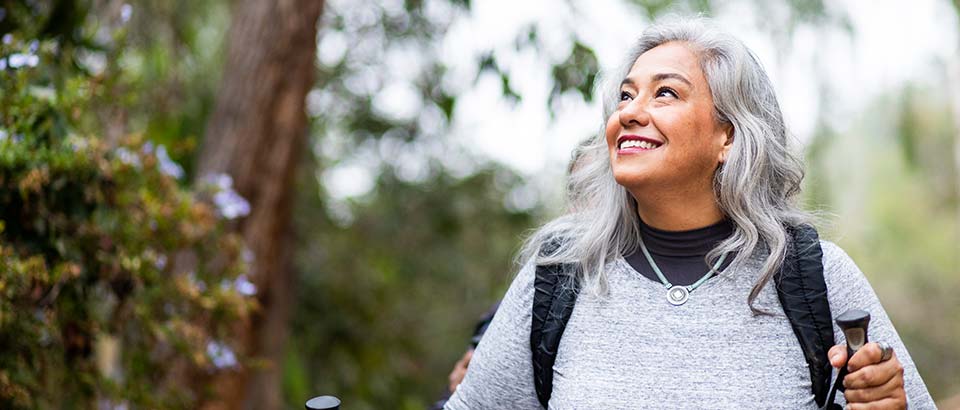September 20, 2024
It’s nearly impossible to have any trip go off without a hitch, but being prepared for an outdoor activity may help to lessen a few bug bites or bruises for your explorers. Before hitting the trails or pitching your tent, we’ll help you pack smarter and stay focused on health and safety with a few easy tips to remember.
Smart Packing for Hiking and Camping
When packing for any outdoor event, keeping in mind the variable elements – like the weather – is key. Pack multiple layers of clothing that you can remove as temperatures rise, and make sure all clothing and shoes fit properly. Pack moisture-wicking clothing, not cotton, and bring multiple pairs of certain items, such as hiking socks, that you can change out of if they get wet.
Meal preparation involves quite a bit of planning, especially when it comes to making sure you can keep perishable items cold and cook them to their proper temperatures. Plan your meals accordingly based on how long you will be away and where you will be cooking them. Pack plenty of ice in an insulated cooler, keep food in waterproof containers, and don’t forget the utensils you’ll need for cooking and eating. Dehydrated foods and healthy snacks like energy bars, dried fruit, jerky, or granola are great for when you’re on the go.
If you’ll be camping for a long period of time or if you run out of drinking water, there are a few ways to purify water sources around you. Techniques include boiling water or using a filtration system sold in many outdoor and recreation stores. For more on how to properly treat water for drinking, the Centers for Disease Control (CDC) has great tips that you can find on their website. It's important to remember that drinking contaminated water can lead to illness and increase the risk of infectious diseases, and it's best to do your research before you go.

Aside from the typical clothing and food items, here are a few things that you might be accidentally leaving off of your hiking or camping list:
- First-aid kit
- Moleskin for blisters
- Compass/GPS
- Map
- Waterproof matches
- Flashlight
- Extra batteries
- Extra blankets
- Medications
- Sunscreen
- Bug repellent
- Fine-tipped tweezers
- Hand soap/sanitizer
- Disinfecting wipes
- Waterproof bags or containers
- Hat
- Sunglasses
- Rain jacket
- Life jacket
- Helmet
- Durable shoes
- Hiking socks
- Safety whistle
Are you bringing along your pets for the family camping trip or hiking excursion? Don’t forget to pack the necessities, including their leash, collar, and harness; food, treats, and drinking water with travel bowls; medications; a towel; and a pet first-aid kit.
Hiking and Camping Safety Tips
Your bags are packed and you’ve chosen your destination. But before you gear up and head out, check off a few hiking and camping safety precautions from your list.
Before You Go
1. Make sure your vaccines are up to date. Your doctor can tell you if you’ve had all of the recommended vaccinations for the appropriate age group to help protect from illnesses or other conditions that could be obtained when hiking or camping. Your pets should see their veterinarian for any vaccine updates, too.
2. Check the weather forecast. While you can still have fun in a little wet weather, severe weather is a reason to take a rain check. Even if the forecast is calling for nothing but sunshine and blue skies, have a contingency plan and bring the appropriate supplies just in case. Weather can often be unpredictable, and if you're exploring an area that is unfamiliar to you, the weather may change more frequently than you're used to.
3. Prevent bug and tick bites. Use a bug repellent on your skin, clothing, outer garments, and gear that lasts for several hours and contains at least 20 percent of DEET (the active ingredient in many insect repellents). If you do find a tick attached to your skin, you can reference the CDC’s website for tick removal instructions, or visit your nearest MedExpress center. For more on preventing tick bites and Lyme disease, read our "5 Tips to Keep You Safe from Ticks and Lyme Disease" blog. And don’t forget about flea and tick protection for your pets!
4. Apply sunscreen to protect from the rays. Whether it is sunny or cloudy, you can still get a sunburn from the sun’s harmful UV rays. Use a water resistant, broad-spectrum protection sunscreen with at least a 30 SPF and reapply every two hours (and even more often if you're working up a sweat or taking a dip in the lake!)
While You’re Exploring

1. Practice safe food preparation. Having limited space can make it tricky when preparing meals for your family camping trip. Ensure you're washing your hands and disinfecting surfaces frequently to prevent any cross-contamination. Cook foods to proper temperatures and chill perishable items in a cooler. And don’t forget fire safety if you're cooking over an open flame.
2. Drink plenty of water. The amount of liquids you should drink depends on many factors, including age, weight, gender, activity levels, and climate, but keep in mind when you break a sweat, you should increase your water intake to avoid dehydration.1 See more above on purifying natural water so that it's safe to drink.
3. Avoid any plants, insects, or animals that you are not familiar with. Don’t be afraid to see the sights while hiking, but keep an eye on where you and your pets are stepping.
MedExpress Pro Tip: Exploring somewhere new? Check out our travel guide to learn more about the insects, plants, weather, and other elements that vary by U.S. region.
4. Swim safely. Swimming is a great way to cool off. Make sure to wear a life jacket if you’ll be kayaking, canoeing, or on any sort of boat, and skip the water entirely if you’re alone or aren’t feeling well.
5. Prevent illness from carbon monoxide. You can’t see or smell carbon monoxide, as it is colorless and odorless; however, it is poisonous and can cause serious illness and even death from breathing it in.2 Make sure to keep your fuel-burning equipment outside of your tent or cabin to prevent buildup of the dangerous gas.
Accidents Happen
Your family is prepared for a great trip, but accidents do happen, so remember to stay calm if something goes wrong. Make sure to write down any emergency contact information given to you by the campground or found at the trailhead, and keep it handy, just in case.
If you become lost, study the area around you, and then use your map, compass, or GPS to determine your location and find your way back to the trail. Your safety whistle can also bring attention to people nearby. Take a buddy with you when hiking or camping, and always tell a friend or family member where you’re headed and when they should expect you back.
If someone on the trip gets a minor injury, use your first aid kit to treat the wounded area and make your way back home or to camp. If the injury is more severe, such as a sprain or break, assess the best way back to safety and call for help if needed. If the person is unconscious or needs immediate care, call for emergency services, whether that is through camp or trail information you were given or by dialing 911.
And if there is a bug bite, scrape, sprain, or other illness or injury that is causing concern, stop in and see us. Our friendly center team helps people get back to feeling their best and enjoying all that summer has to offer.
Now that you know the basics, you’re ready for a safe and healthy outdoor adventure. The U.S. has more than 200,000 miles of trails on federal and state lands, so it’s about time you get out there and start fearlessly exploring them!1
Originally published June 2019. Updated September 2024.
References:
1 CDC. Fast Facts: Data on Water Consumption. Last updated January 19, 2024. Accessed August 15, 2024.
2 CDC. Carbon Monoxide Poisoning Basics. Last updated April 17, 2024. Accessed August 12, 2024.
3 American Hiking Society. Hiking trails in America: Pathways to prosperity. Last updated June 2015. Accessed April 10, 2019.
